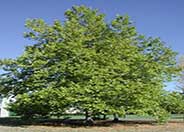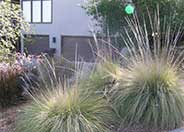
Common name:London Plane Tree
Botanical name:Platanus hispanica
London Plane Tree is a fast growing, deciduous tree that reaches a size 40'-80' high by 30'-40' wide. Its leaves are 3-5 lobed, with a width of 4"-10". This plant is tolerant of most soils, smog, dust and reflected heat.

Common name:Centennial Coyote Brush
Botanical name:Baccharis 'Centennial'
This plant is a hybrid that combines a prostrate habit with tolerance for desert conditions. It grows 3' tall and 6' wide. It tolerates heat, sun and frost, maintaining its green appearance.

Common name:California Poppy, Golden Poppy
Botanical name:Eschscholzia californica
This small annual (sometimes acts as a perennial) plant will grow to less than 1' tall and has light, small blue green leaves with gold and orange flowers that bloom in spring and summer.

Common name:Deer Grass
Botanical name:Muhlenbergia rigens
The Deer Grass is a warm season perennial that forms dense clumps from the base. The spike-like flower stalks grow 3' tall and this grass has striking foundation form. The Deer Grass is native to California and needs watering once or twice a month after it has been established. The more water it has, the greener it is.
Maintenance Tips
Muhlenbergia rigens is a dense grass with a dome-shaped structure arching in all directions. It is commonly referred to as Deergrass. The foliage can reach 3' tall and 5' wide with flower blooms that emerge in the spring and summer 18" above the foliage. This grass requires almost no maintenance if it is planted in its ideal conditions. A sunny location, well-drained soil, and the space to reach its mature size will ensure that it thrives without having to prune for size or shape. It is common to cut back perennial grasses very hard in the winter to prune off the old spent flowers. If you are planning on winter pruning, it is best to wait until you see some new foliage emerge so the newly emerging leaves can cover the cuts quickly.
Common name:Canyon Prince Wild Rye
Botanical name:Leymus condensatus 'Canyon Prince'
One of the best known and utilized native grass selections in Southern California, this beautiful, blue gray foliage spreads out 3'-4' or more. It will reach a height of 2'-3'. It rarely flowers. It does spread by rhizomes although not as vigorously as some closely related species. It can be extremely drought tolerant and care must be taken not to over water this species as it can rot from the center. Otherwise, it is carefree and requires virtually no maintenance.
Designer: Bill Butler
Photographer: GardenSoft
Incorporate compost 6" into your soil to retain water, reduce compaction, feed earthworms, and provide valuable nutrients to your plants.
Attract, or buy beneficial insects such as ladybugs and lacewings to control pest outbreaks in your garden.